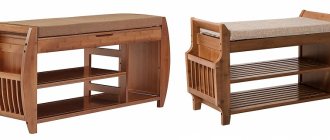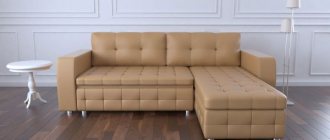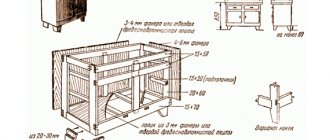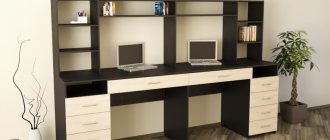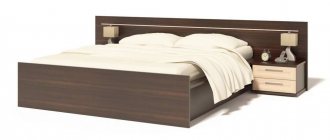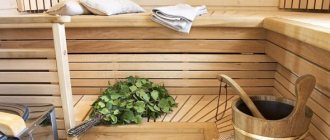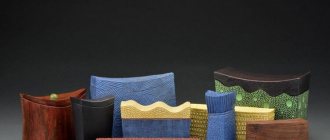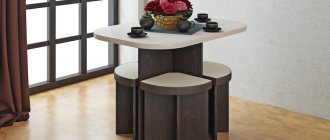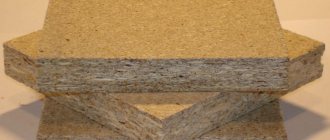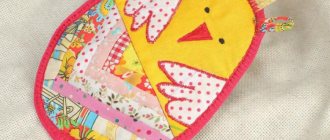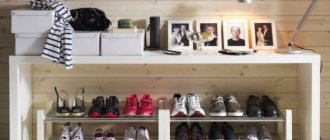In the hallways there are two types of storage places for shoes: for those that are worn now and those that will be needed in other seasons. In the second case, space is allocated in closets and wardrobe compartments. Narrow shelves, drawers and baskets, various storage systems and organizers allow you to bring order and consistency. But for the first case, some kind of separate cabinet, chest of drawers or do-it-yourself shoe rack, made of the right size for the hallway, will come in handy. I selected photos and drew drawings and diagrams of the most successful models of narrow functional shoe holders and overshoes, which can be purchased ready-made or made independently.
Why you should make a shoe rack with your own hands for the hallway
The problem of placing shoes worn at a given time in the hallway can be solved in different ways. Typically, low cabinets with a soft seat are used for storing seasonal shoes and slippers - they are also called shoe boots.
They also design open shelving with shelves for shoes of shallow depth. If you place the shelves at an angle, you can make the rack narrower - after all, its depth is determined by the size of the shoes.
A slim shoe rack is perhaps the best option possible. In the reference book with a list of furniture and interior items, I defined “slim”. Essentially, this is a shoe rack with a rotating mechanism that you can make with your own hands.
Due to the fact that the shoes are in an almost vertical position, the depth of such a cabinet is very small - ideal for small and narrow hallways.
Since a shoe rack of this type is narrow and unstable, it must be attached to the wall. You can make it hanging, which will give the interior an additional zest and allow you to slide something under the body of the cabinet. Often a mirror is hung above a shoe rack, and its lid is used as a shelf for all sorts of small things, which is also very convenient. You can screw hooks, hangers for umbrellas and bags with your own hands to the side of the shoe rack - this will expand the functionality of the furniture and add comfort to the interior of the hallway.
The benefits of making your own shoe cabinet of the desired design are obvious:
- In order to make a shoe rack with your own hands, you can use scrap materials and any leftovers.
- The design of a typical shoe cabinet is extremely simple, and the variety of drawings and photos allows you to choose the best option.
- Since the material consumption is low, as is the cost of the product, such projects are reluctant to be commissioned. You can immediately save yourself time and do it yourself.
Installation of shoe boots
Now we will need to install the mechanisms for the shoe rack. They are attached to the sides. Below are the installation dimensions and mounting drawings of these mechanisms:
To make it easier to figure out the installation dimensions and easier to install the opening mechanism for our shoe rack, you can use the drawings below.
On the sidewalls you need to mark the attachment points for the rotation axis and the stop pin, and you can immediately screw the panels to the sidewalls.
Our shoe shoe has a standard size: 192*287*85*16 . First, make markings for future fastening of the plastic part according to the above drawing and installation diagram (for each shoe shoe, the kit always includes a drawing and a wiring diagram for its installation, according to which, in fact, the installation should be carried out).
First of all, the shoe shoe needs to be screwed to the sidewalls of the chipboard using self-tapping screws. In this case, pay attention to the fact that the shoe shoe should tilt freely and return to its original position.
Now you need to connect the parts made of chipboard (the shoe shoe itself), the thickness of which is 10 mm, and the plastic parts of the shoe shoe.
Do this in stages. That is, first you insert the parts into special grooves and screw them with self-tapping screws to the left side panel, then to the internal vertical partition. After that, repeat these steps with the back of the partition and the right side.
At the next stage, all we have to do is install the facades, handles and thrust bearings.
For more precise installation of facades, you can use double-sided tape. Those. The fronts here can be installed in the same way as on a regular drawer.
We glue double-sided tape onto the shoe shoe, try on the facade, press it and screw it.
Please note: in our detailing, the dimensions of the facades for cutting and edging are already indicated with the necessary indents and gaps of 2 mm on each side. Also, based on the installation drawing of the shoe shoe, the gap of the facade from below should be at least 7 mm!!!
That is, step by step, we have:
- The height of the opening for the facade is 326 mm.,
- height of the facade in detail 311 mm.,
- when we glue the edge to the facade, we will add 2 mm on each side - it will already be 315 mm,
- you will also need 2 mm for the gap,
- As a result, in an opening with a height of 326 mm there will be a facade with a height of 315 mm (2 mm each for the gap at the top and bottom, plus an additional gap of 7 mm at the bottom).
Next, mark the holes for the handles and screw them on.
At the very end, all we have to do is screw on the thrust bearings and at this point the assembly can be considered complete.
DIY shoe rack with seat, photos and drawings
The most comfortable sitting height is 350-500mm above floor level. The width of the seat must be at least 300mm. Most often, a compact shoe rack with a seat with your own hands has dimensions of 400x600x350mm. You can make the shoe cabinet longer and higher if the size of the hallway allows it.
DIY shoe rack made from pipes, photos and drawings
Such a small and practical piece of furniture can be made from scrap materials - everything that is left over. For example, use pipe cuttings.
In this case, the shoe rack can be made in the form of a tall narrow cabinet for shoes or a shoe cabinet with a seat.
Pipes can also be used as supports for shelves. For example, in the implementation of a carousel shoe rack with a rotating base.
The rotating element is a conventional TV rotating mechanism with a square platform. To ensure stability of the cabinet, you can make the base larger; the height should not exceed the radius of the shelves without additional weighting the center of the structure.
Types of opening mechanism
The most common 4 types of mechanisms for opening cabinets for shoes:
- Hinged doors with fixed shelves. The cabinet compartments fold down and contain shelves with shoes. Plus - they take up little space, minus - they are poorly ventilated.
- Swing. Furniture doors open outward and are located vertically due to fastenings. Plus - the mechanism is convenient for opening, minus - they require additional free space.
- Sliding. There are two doors, one of which moves to the side when opened. The most inconvenient model due to the way the doors slide, but it takes up little space.
- Pull-out drawers. Inside there are shoes standing on the bottom; when opened, the drawers slide out towards themselves. Placement requires a lot of space, but such models are easy to use.
The cost of the cabinets depends on the door opening mechanism. The most expensive ones are swing and folding ones.
Folding
Swing
Sliding
Pull-out drawers
DIY narrow shoe rack with inclined shelves, photos and drawings
The greater the slope of the shelves, the narrower the shoe rack itself can be made. But you will need to provide some kind of stopper that will prevent boots, sneakers and other items from sliding off the surface of the shelves due to the slope. The stopper can be made from a wooden or metal tube, or a narrow strip of chipboard or wood.
As inclined shelves, you can use special nets for wardrobes with a side.
I recommend that you familiarize yourself with the range of such components in various wardrobe systems and related accessories for sliding systems (such as Commander, Find, Aristo, etc.). There are a lot of storage systems for hallways and dressing rooms with fastening to the side and back walls, as well as the placement of shoes in a vertical position (sole top) on “peaks” and “petals”.
Edging parts
At home, it is possible to veneer only with a paper edge, because for a plastic edge you need a special machine and glue , which, when heated to high temperatures, ensures good adhesion of the edge to the part.
It is recommended to cover visible parts with a thick PVC edge, that is, 2 mm thick. The visible details, in our case, are:
- Roof,
- Bottom,
- facades,
- Sidewalls.
All internal parts and partitions in overshoes can also be covered with PVC edges, but with a thickness of 0.5 mm. You will need to hand over the detailing to the furniture shop craftsmen, which will also indicate how to veneer the parts.
DIY shoe rack made of wood and scrap materials
Strictly speaking, chipboard is not the best option for storing wet shoes. It does not have the required moisture resistance and requires more careful use. Therefore, a shoe rack made of wood, metal, MDF, or furniture board seems a more attractive option for making it yourself.
In addition, wood, plywood and furniture panels provide more opportunities in the design of a shoe cabinet. Hollow and openwork-shaped sidewalls can be used as supports.
Or in a simpler version - using timber as supports.
In general, you can use any scraps and materials at hand to make a shoe cabinet with your own hands.
Style and color
A variety of furniture options allows you to choose a cabinet in a wide variety of colors, even for small-sized corridors. The product is purchased depending on the interior style:
- For rooms designed in a classic style, a medium-sized model is suitable. The ideal option is a white cabinet, because it is this kind of furniture that reflects light and visually enlarges the space. Also, wooden products in noble brown shades, from the lightest to wenge, will fit into such an interior.
- A model similar in size to a small closet will fit into a hallway made in a rustic style (country or Provence). The colors of the wood should be natural, and the surface should be coated with impregnation that does not hide the natural texture.
- A loft-style corridor is ideally complemented by low or high and wide products. Popular color options are bamboo, dark blue, dark brown, black.
- Modern styles are characterized by a lack of pronounced decor and simple forms. Therefore, an interior in a minimalist or hi-tech style will organically complement plain products with a glossy surface.
The most popular are wooden cabinets with a natural protective coating, always wide, up to 120 cm high, as well as closed-type options with retractable drawers.
Classic style
Country
Provence
Loft
Modern
